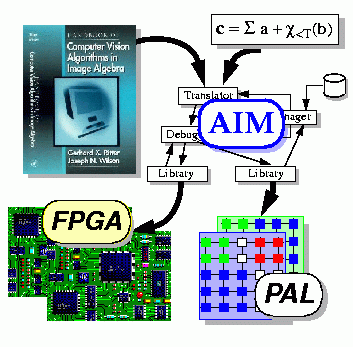University of Florida / Center for Computer Vision & Visualization
AIM Project - Adaptive Image Manager
Sponsor: DARPA/ITO Adaptive Computing Systems Program
Department of Computer & Information
Science & Engineering
University of Florida
P.O. Box 116120
Gainesville, FL 32611-6120
AIM Overview
Tasks performed by image
and signal processing (ISP) hardware are growing in complexity due to
a nonlinearly increasing image data burden and increased depth of
computation incurred by more sophisticated image understanding or
compression algorithms. Power and space limitations upon on-board
processor design motivate the increasing prevalence of distributed
computation for ISP algorithms. In realistic airborne sensing and
processing scenarios, processor fault and failure rates can increase
due to a variety of hazards such as channel jamming and exposure
to various types of radiation. Hence, it is reasonable to expect
that fault tolerance should be built into software that maps ISP
algorithms to such hardware systems.
In response to this situation, the AIM Project proposes to radically
enhance the Parallel Image Manager (PIM) server developed at
University of Florida's Center for Computer Vision and Visualization
(UF/CCVV), to map image and signal processing (ISP) algorithms around
faulting or failing components in a heterogeneous network of
processors. All or a portion of such hardware could be reconfigurable
SIMD or SMP processors as well as machines based on field-programmable
gate arrays (FPGAs). In practice, each device could exhibit
idiosyncratic faulting or failing behaviors.
AIM's Status Manager and Multi-Level Debugger would
implement fault tolerance by routing the algorithm mapping process
around defective hardware. We expect to achieve this goal via a
periodically-updated status map that would describe the state of each
hardware component in a given computational system. Status updates
would be relayed by flexible libraries designed to control and monitor
computational hardware.
Advantageous Features. In practice, AIM would have the
following practical advantages:
- Application- and Architecture-Independent Programming Interface
that would use image
algebra as the algorithm representation language. Image
algebra was developed at UF under DARPA and Air Force sponsorship
for over a
decade, and has been implemented on numerous workstations and parallel
processors. Image algebra is a concise, rigorous, computationally
complete notation that unifies linear and nonlinear mathematics in the
image domain, and hence presents a unifying notation for signal and
image processing.
The PIM server can support a Khoros interface designed in-house.
This capability would be extended to the AIM system. Additionally,
UF/CCVV's Image Algebra
Project is developing an equation-editor
type of GUI for entering mathematical representations of image
algebra, which would write error-free
image algebra C++ code.
We thus expect to drastically reduce software development and
testing time, as we have by using image algebra in previous research.
- Fault Tolerance due to algorithm mapping that is
constrained by status information about each processor and network
communication channel.
- Computational Efficiency resulting from optimization
heuristics inherent
in PIM, which we plan to extend throughout the AIM project.
- Rigor and Computational Completeness due to the use of
image algebra, which can express all image and signal processing
operations in terms of a compact collection of operations (less
than one dozen operations in nonrecursive image algebra).
Key features of AIM are Symbolic- and Execution-Level Debuggers that
would work together with AIM's Status Manager to determine whether or
not incorrect assignments of operations to given hardware components
were scheduled. For example, if a 3x3-pixel convolver was suddently
unavailable (due to a fault or failure mode), another device with
similar capabilities would be located, where available, and would be
substituted for the original resource, when available. Meanwhile,
computations originally mapped to the convolver would be suspended,
thereby implying sophisticated capabilities for managing out-of-order
execution. Such capabilities have been developed in part for PIM,
and would be greatly enhanced in the AIM system.
Technical Challenges. Expected areas of scientific or
technical difficulty include:
- Development of Computational Models that describee processor
faulting and failing behaviors as well as routine functionality.
Such models are currently under development for a variety of
processors, including Lockheed-Martin Corporation's PAL-I and
PAL-II, MasPar MP-2, Cambridge Parallel Processing Gamma-II SIMD
machines, SGI Enterprise 2000 SMP machine, and a variety of
FPGA-based processors.
- Mapping between Logical (Software) and Physical (Hardware)
Models to achieve implementation of an algorithm or expression
on a given ensemble of computational hardware. This problem is
being solved via a multi-level modelling approach that utilizes
the Open Distributed Processing Reference Model (ODP/RM) at a
high level, capability-based scheduling at an intermediate level,
and is expected to employ VHDL-to-bitmap compilation to derive
FPGA configuration maps for small functional units (e.g., within
an FPGA partition).
- Development and Implementation of Performance Measures
that describe and provide a basis for the evaluation of efficiency,
reliability, and accuracy of algorithm-to-hardware mapping strategies
employed in the AIM software.
 AIM Personnel and Partners
AIM Personnel and Partners
- Principal Investigator
Gerhard X. Ritter is
Professor and Chair of the CISE Department, Professor of Mathematics,
and Director of the Center for Computer Vision and Visualization.
- Co-Principal Investigator and Project Leader
Mark S. Schmalz is
a faculty member in the CISE Department.
- Co-Principal Investigator
Joseph N. Wilson is
a faculty member and Associate Chair of the CISE Department.
- Graduate Students include:
- Undergraduate Students include:

- Subcontractors include:
Lockheed-Martin Electronics and Missiles
 Group, Orlando, FL; and
Group, Orlando, FL; and
Lockheed-Martin Sanders, Nashua, NH
AIM Facilities
The Center for Computer Vision and Visualization is one of four research
centers at University of Florida's
Department of CISE. All UF/CCVV personnel have access to the
Departmental network of over 200 Sun and SGI workstations, monochrome
and color laser printers, file servers, etc. UF/CCVV is affiliated with
UF/CISE's Parallel Research Laboratory (PRL), which has a 64-processor N-Cube
MIMD machine, 1,024-processor MasPar MP-2 and 9,120-processor PAL-I SIMD
machines.
The PAL processor is the first in a series of fast, compact SIMD machines
designed for image and signal processing applications. Developed under
the sponsorship of the PAL consortium (USAF Research Laboratory,
Lockheed-Martin Corp., and University of Florida), PAL-I is capable of
more than 385 MOPs (8-bit operations). PAL-II, which is in fabrication,
is expected to achieve peak throughput of 2.5 GOPs (32-bit IEEE floating
point operations) in a 4x6-inch form factor.

AIM Project Information
Publically-available project data are grouped as follows:
This document is Copyright © 1997,1998 by UF/CCVV.
All rights reserved, except for use by the U.S. Government
and its agencies or contractors.
 Principal Investigator:
Principal Investigator:  G.X. Ritter (ritter@cise.ufl.edu)
G.X. Ritter (ritter@cise.ufl.edu) M. S. Schmalz (mssz@cise.ufl.edu)
M. S. Schmalz (mssz@cise.ufl.edu) Principal Investigator:
Principal Investigator:  G.X. Ritter (ritter@cise.ufl.edu)
G.X. Ritter (ritter@cise.ufl.edu) M. S. Schmalz (mssz@cise.ufl.edu)
M. S. Schmalz (mssz@cise.ufl.edu) AIM Personnel and Partners
AIM Personnel and Partners
 Group, Orlando, FL; and
Group, Orlando, FL; and 